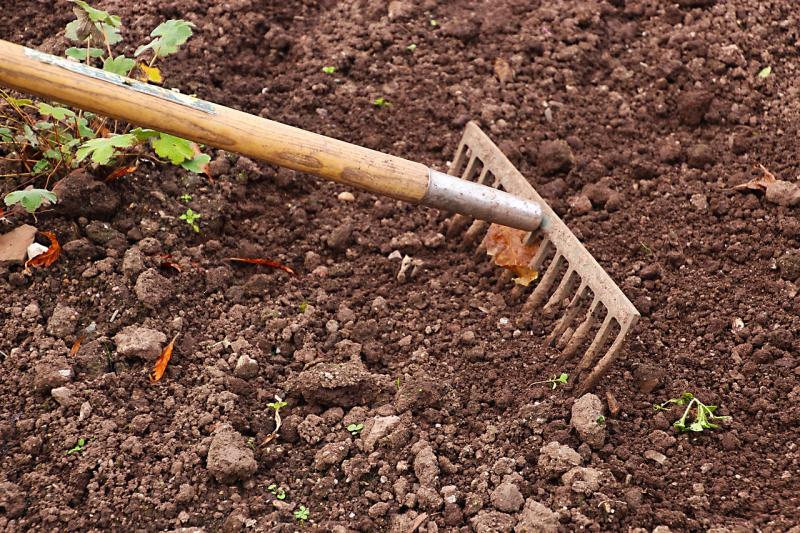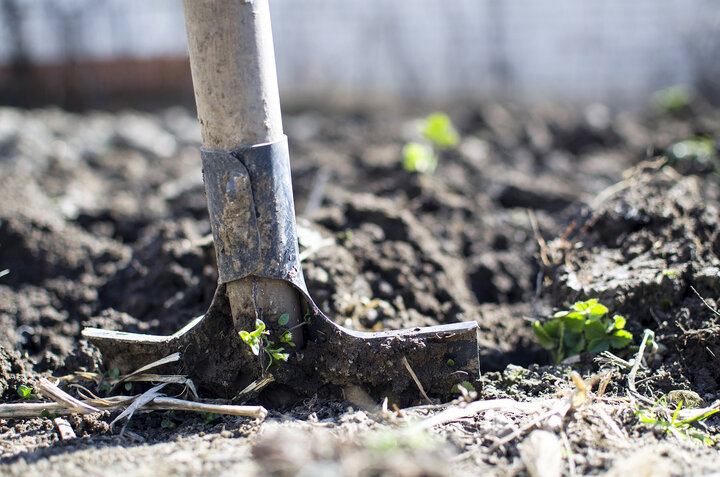Sarah Browning, Nebraska Extension Educator

Ready to take soil samples for a testing kit. Image by Pixabay.com
Fall is the best time of year to improve the soil in your garden beds for several reasons.
- First, spring rains often hamper a gardener's ability to get into the garden and work the soil as needed to prepare for planting.
- Fall preparation gets your gardens into a "planting ready" state, so you can begin a new gardening season whenever spring temperatures are favorable, and take advantage of spring moisture, which may be particularly important for gardening success next spring, since soils are so dry following summer's hot, dry conditions.
- Adding soil amendments in fall also takes advantage of winter's repeated freezing and thawing of the soil, to gradually mix and incorporate them.
- Fall addition of manure provides time for human food safety pathogens to die-off before next spring's harvest season begins.
If you're concerned about the soil quality in your landscape, whether it's your turfgrass, ornamentals or vegetable garden, a soil test can give you basic information to help you start improving it. Soil testing isn't very expensive or difficult to do and can be done anytime the soil is not frozen.
Soil Testing Labs
Start by locating a soil testing laboratory near you. Several labs are available in Nebraska including: AgSource in Lincoln,https://agsource.com, (402) 476-0300; and Midwest Laboratories in Omaha, http://www.midwestlabs.com/, (402) 334-7770. On their websites, soil testing can be found under "Agronomy & Feed" at AgSource and under "Agriculture" at Midwest Labs. Contact the lab or visit their website to request a soil sample test kit and submittal form. Testing costs approximately $25.00 per sample. There are additional Nebraska soil testing labs - find one near you.
Collecting a Soil Sample
Decide how many soil samples are necessary for your landscape. One sample is usually sufficient for most landscapes unless there are obvious soil differences, then each unique area should be sampled separately. It can also be beneficial to sample areas separately based on their usage, so that samples are submitted individually for turf, ornamentals and vegetable gardens.

Create your soil sample by taking 10-15 soil cores from random locations within the sampling area. If you don't have a soil probe, you can use a shovel to collect samples at a 5-6 inch depth. Remove any vegetation or thatch from the soil cores and combine them all into one container. This aggregate collection of soil is your sample. Place 1 to 2 cups of well-mixed soil in a plastic bag or the sample container provided by the lab.
Guidelines for Soil Sampling, Nebraska Extension
Which Tests to Run?
Choose a test that will give results for residual nitrogen, phosphorus, potassium, organic matter, cation exchange capacity (CEC) and soil pH. Your soil test results will usually arrive in about two weeks, along with recommendations for soil amendments in your landscape based on the plant types you indicated on the submittal form.
If you have questions about reading the soil test results or potential soil amendments for your garden, call your local Nebraska Extension office or your state's Extension system.
Changing Soil pH
Once you have the test report, soil pH is an important reading to check. Ideal pH range for most plants is 6.0 -7.0. However, many eastern Nebraska soils, that have not been farmed, are naturally pH 7.5 or above. Soil pH is measured using a logarithmic scale, so pH 7 is ten times more alkaline than pH 6. Below pH 5.5 or above 7.5, soil modification may be necessary to grow pH sensitive plants such as pin oak, river birch, rhododendrons or azaleas, because soil pH directly influences the availability of many nutrients. But gardeners can also work with the existing soil, and choose plants adaptable to higher pH, avoiding the need for pH adjustment in many cases.
If you need to add sulfur or lime to change soil pH, fall application allows time for the chemical reactions to take place that are necessary for a pH change to occur.
Elemental sulfur or aluminum sulfate are most commonly used to lower soil pH, however, large amounts of sulfur are required to make even a small change. For example, a loam soil with pH 7.5 requires 15-20 pounds of elemental sulfur per 1000 sq.ft. to reach soil pH 6.5. Modified soil will revert in time to it's original pH level, so it is often better to use pH adaptable plants in your landscape than to use plants with more strict pH requirements.
Lime is used on acidic soil to raise pH. Land that has been farmed may be pH 5.5 or below, and could benefit from the addition of lime.
Always base your addition of sulfur or lime on soil test recommendations, rather than adding products on a hunch.
Tips for Soil Amending
Some soil amendments are not recommended for Nebraska soils. For example, wood ashes are very alkaline, which isn't helpful when added to Nebraska's typical alkaline soil. Sand added to heavy Nebraska clay soil creates a texture similar to concrete, so don't do it! Gypsum is another soil amendment commonly discussed by homeowners to "sweeten" soil or lower soil pH, but in fact it does neither and is seldom a helpful amendment for Nebraska soils. Gypsum should only be used on soil with high levels of salt, where is can bind with the salt molecules and aid in moving them out of the soil profile.
- Soil amending can be done in spring, but don't work the soil when it is wet to avoid soil compaction and the creation of hard clods. Fall is an excellent time of year for soil amending, because it allows time for the soil structure or chemistry to change before a new growing season begins.
- Organic matter breaks down over time, so raising and maintaining your soil's organic matter content will require repeated amendment.
- Keep in mind that Nebraska's clay soils have a high buffering capacity or the ability to revert to the original pH level after amendment with sulfur. Maintaining a lower soil pH will require repeated amendment.
Another great resource is the publication "Fertilizers for Vegetables in Home Gardens", which contains detailed information on adjusting soil pH, amending with organic matter and adding fertilizer.
Adding Manure
If you're applying manure to provide nutrients or increase soil organic matter, fall applications are very important. Animal manures often contain microorganisms that are harmful to humans, such as Salmonella and E. coli. For that reason, the use of fresh manure is not recommended in the vegetable garden where microorganisms could contaminate food as it is grown and harvested. Fall manure applications give additional time for harmful microorganisms to die before a new crop is grown.
Composted or aged manure, which has been allowed to sit and begin to break down for at least a year, is a better choice for the vegetable garden. If fresh manure must be used, make sure it is not applied to the soil within 120 days of the next harvest. Horse, cow, sheep, or poultry manure is fine, but do not use swine manure because of the higher potential for contaminants.
So while our great fall weather continues, there is still time to improve your garden soil and ensure better growing conditions next year.
Images by Pixabay.com.